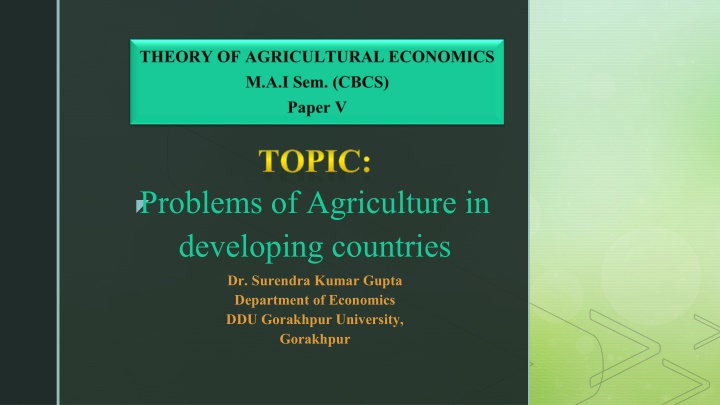
Challenges Faced by Agriculture in Developing Countries
Explore the history and problems of agriculture in developing countries, particularly in India. From small land holdings and poor socio-economic conditions to inadequate technology and reliance on weather, the sector faces numerous challenges. The lack of production incentives and poor rural infrastructure in developing countries add to these issues, hindering agricultural progress.
Download Presentation

Please find below an Image/Link to download the presentation.
The content on the website is provided AS IS for your information and personal use only. It may not be sold, licensed, or shared on other websites without obtaining consent from the author. If you encounter any issues during the download, it is possible that the publisher has removed the file from their server.
You are allowed to download the files provided on this website for personal or commercial use, subject to the condition that they are used lawfully. All files are the property of their respective owners.
The content on the website is provided AS IS for your information and personal use only. It may not be sold, licensed, or shared on other websites without obtaining consent from the author.
E N D
Presentation Transcript
TOPIC: Problems of Agriculture in developing countries Dr. Surendra Kumar Gupta Department of Economics DDU Gorakhpur University, Gorakhpur
History & Characteristics of Agriculture Agriculture in India has a long history, dating back ten thousand years. ( , ) It began by 9000 BC as a result of early cultivation of plants and domestication of crops and animals. During British Rule agriculture was a way of living and the farmer produced merely for self- consumption. Food crops like wheat and rice were the most important The middle ages saw irrigation channels reach a new level of sophistication in India and Indian crops affecting the economies of other regions of the world. Land and water management systems were developed to provide uniform growth However, during the British Period, when the industrial revolution was going on in England (1780-1820 over to commercial crops like cotton and indigo and started providing financial assistance to farmers through zamindars and British agents to export the surplus cash crops to England.), the British forced farmers to switch.
Conti..Conti.. There was continuous exploitation of natural resources and economic wealth from India till Independence wasachieved. Due to this economic drain, there was permanent loss of India s national income and wealth. The result was that by the mid-nineteenth century, traditional handicrafts were completely wiped out and artisans lost their hereditary occupations. This led to their migration to agriculture for their livelihood and made this sector over crowded, a process called de- industrialisation , which led to stagnation inthe Indian economy.
Conti. Nevertheless, independent India was able to develop a comprehensive agricultural program that s why government was started first five year plan with the major objective of agricultural development. The first agricultural census was started in 1970- 71(July-June) as part of the 1970 World Agricultural Census Program sponsored by FAO. It collects agricultural information such as number, area, tenancy, land utilization, cropping pattern and irrigation particulars of different sizes.
PROBLEMS BEFORE THE AGRICULTURE The average size of land holdings is small Poor socio-economic condition of farmers Use of technology is inadequate No proper management of irrigation The agriculture sector faces the disastrous consequences of hazards Dependence of agriculture on weather
Developing Countries Production incentives are lacking Poor state of rural infrastructure
Conti . In nutshell problems of agriculture in developing countries can be divided into three segment. General Problems problems Institutional Technical Problems 1.Problems of Finance 2. Lack of Marketing Facilities 3. Small Size of Land Holdings 4. Land Ownership 1. Natural Disaster 2. Pressure of Population on Land 3. Social Cause 1.Old Agricultural Technology 2.Insufficient Facility of Irrigation
